The Influence of Environment Factors on Chronic Non-Communicable Diseases in a Heavy Industry City—A Case of Xigu District of Lanzhou City
Abstract
:1. Introduction
2. Materials and Methods
2.1. Overview of the Study Area
2.2. Data Sources
2.3. Research Methods
2.3.1. Moran Index
2.3.2. Geographic Detector
3. Results
3.1. Significant Change Characters in the Time Series of NCD in Xigu District
3.2. Spatial Distribution Characteristics of NCD in Xigu District
3.3. Obvious High Cluster of NCD during the Heating Period and the Non-Heating Period
3.4. Natural Environment and Built Environment Factors Applied Significantly Different Acting Force on NCD
4. Discussion and Outlook
4.1. Main Findings
4.2. Strengths and Limitations
4.3. Recommendations and Prospects
5. Conclusions
Author Contributions
Funding
Institutional Review Board Statement
Informed Consent Statement
Data Availability Statement
Conflicts of Interest
References
- Yun, J.; Xiangyu, T. The current situation and countermeasures of the health education of self-management for diabetes patients. J. Nurs. Adm. 2005, 2, 29–30. [Google Scholar]
- Wei, M. The report of preventing chronic diseases released by WHO. Chin. Med. J. 2005, 45, 72. [Google Scholar]
- Evans, J.; Allan, N.; Cantle, N. A New Insight into the World Economic Forum Global Risks. Econ. Pap. A J. Appl. Econ. Policy 2017, 36, 185–197. [Google Scholar] [CrossRef]
- Cherian, V.; Oyere, O.; Walter, J. Organizational Update: World Health Organization. Stroke 2017, 48, 341–342. [Google Scholar]
- Jian, L.; Miaomiao, A.; Ying, X.; Jin, L.; Shuang, Y. The association between dietary fiber intake and the risk of chronic non-communicable diseases. Prog. Mod. Biomed. 2018, 18, 4194–4197. [Google Scholar]
- Cai, Q.; Dekker, H.L.; Vinke, P.C.; Corpeleijn, V.E.; Stephan, J.L.; Borst, B.; Navis, G.J. Diet quality and incident chronic kidney disease in the general population: The Lifelines Cohort Study. Clin. Nutr. 2021, 40, 5099–5105. [Google Scholar] [CrossRef]
- Yufeng, G.; Ying, L.; Xiaojie, L.; Yousheng, Q. Investigation and analysis of the epidemiology and influencing factors of chronic diseases among adults in Huairou District. J. Cardiovasc. Pulm. Dis. 2020, 39, 885–889. [Google Scholar]
- Lei, C.; Xiaofei, H.; Jiali, Y.; Lin, H. Investigation and analysis of influencing factors on chronic disease prevention of urban residents in Wenzhou. Chin. Rural. Health Serv. Adm. 2017, 37, 436–439. [Google Scholar]
- Lari, A.; Sohouli, M.H.; Fatahi, S.; Cerqueira, H.S.; Santos, O.; Pourrajab, B.; Rezaei, M.; Saneie, S.; Rahideh, S.R. The effects of the Dietary Approaches to Stop Hypertension (DASH) diet on metabolic risk factors in patients with chronic disease: A systematic review and meta-analysis of randomized controlled trials. Nutr. Metab. Cardiovasc. Dis. 2021, 31, 2766–2778. [Google Scholar] [CrossRef]
- Gylling, A.T.; Eriksen, C.S.; Garde, E.; Wimmelmann, C.L.; Reislev, N.L.; Bieler, T.; Ziegler, A.K.; Andersen, K.W.; Bauer, C.; Dideriksen, K.; et al. The influence of prolonged strength training upon muscle and fat in healthy and chronically diseased older adults. Exp. Gerontol. 2020, 136, 110939. [Google Scholar] [CrossRef]
- Wei, S.; Wenling, L.; Xuejing, Y.; Wenhui, L. Investigation and analysis of chronic diseases and their influencing factors in Heping District, Tianjin. Pract. Prev. Med. 2016, 23, 726–727. [Google Scholar]
- Mendis, S.; Davis, S.; Norrving, B. Organizational Update: The world health organization global status report on noncommunicable diseases 2014.one more landmark step in the combat against stroke and vascular disease. Stroke 2015, 46, 121–122. [Google Scholar] [CrossRef]
- Astell-Burt, T.; Feng, X. Urban green space, tree canopy, and prevention of heart disease, hypertension, and diabetes: A longitudinal study. Lancet Planet. Health 2019, 3, 16. [Google Scholar] [CrossRef]
- Jung, J.; Park, J.Y.; Kim, Y.C.; Lee, H.; Kim, E.; Kim, Y.S.; Lee, J.P.; Kim, H. Effects of air pollution on mortality of patients with chronic kidney disease: A large observational cohort study. Sci. Total Environ. 2021, 786, 147471. [Google Scholar] [CrossRef]
- Liang, Z.; Wang, W.; Yang, C.; Wang, Y.Y.; Shen, J.S.; Li, P.F.; Ma, L.; Wei, F.; Chen, R.; Liang, C. Residential greenness and prevalence of chronic kidney disease: Findings from the China National Survey of Chronic Kidney Disease. Sci. Total Environ. 2021, 806, 150628. [Google Scholar] [CrossRef]
- Yao, Y.; Xi, C.; Wu, C.; Han, Y.Q.; Xue, T.; Wang, J.X.; Qiu, X.H.; Que, C.L.; Zheng, M.; Zhu, T. Differences in transcriptome response to air pollution exposure between adult residents with and without chronic obstructive pulmonary disease in Beijing: A panel study. J. Hazard. Mater. 2021, 416, 125790. [Google Scholar] [CrossRef]
- Yu, W.H.; Ai, Y.H.; Yang, M.; Liu, J.P. Detecting “Hot spots” of facility POIs based on kernel density estimation and spatial autocorrelation technique. Geomat. Inf. Sci. Wuhan Univ. 2016, 41, 221–227. [Google Scholar]
- Rouli, D.; Xin, L. Multivariate logistic analysis of risk factors for the onset and prognosis of patients with different types of coronary heart disease in Jiangsu Province. Pharm. Clin. Res. 2020, 28, 353–358. [Google Scholar]
- Shi, Y.N.; Shi, Y.; Fan, C.S. Associating factors of hypoglycemic drug adjustment during hospitalization among diabetic population: A logistic regression analysis based on 130 hospital-data of US. Hainan Med. J. 2020, 31, 2594–2597. [Google Scholar]
- Juan, L. Analysis of global distribution mode of theft crime rate based on Moran Index. Police Technol. 2014, 1, 45–46. [Google Scholar]
- Guihong, L.; Fang, W.; Qian, W. Influence of chronic disease resource utilization on medication adherence among elder patients with primary hypertension in minority areas. Chin. J. Mod. Nurs. 2017, 23, 4072–4075. [Google Scholar]
- Chen, Z.; Liu, J.; Wei, C.; Li, J.; Pan, J.J. Incidence of chronic diseases, medical care-seeking intention and its influencing factors among the community-dwelling elderly in Changsha city. Pract. Prev. Med. 2020, 27, 270–273. [Google Scholar]
- Hao, L.; Mingxin, Z.; Ran, W. The effects of regional geographical factors on children’s respiratory diseases in Jingyuan, Ningxia. Geogr. Res. 2019, 38, 5–10. [Google Scholar]
- Hosseini, Z.; Safari, A.; Khan, N.A.; Veenstra, G.; Conklin, A.I. Gender differences in the role of social support for hypertension prevention in Canada: A population-based cross-sectional study of the CLSA cohort. CJC Open 2021, 9, 45–46. [Google Scholar] [CrossRef]
- Gu, J.; Yang, C.; Zhang, K.; Zhang, Q. Mediating role of psychological capital in the relationship between social support and treatment burden among older patients with chronic obstructive pulmonary disease. Geriatr. Nurs. 2021, 42, 1172–1177. [Google Scholar] [CrossRef]
- Fatimah, D.; Rachmi, S.F.; Indracahyani, A. The relationship between social support and emotional status among patients with chronic obstructive pulmonary disease. Enferm. Clín. 2019, 29, 134–138. [Google Scholar] [CrossRef]
- Patino, J.E.; Hong, A.; Duque, J.C.; Rahimi, K.; Zapata, S.; Lopera, V.M. Built environment and mortality risk from cardiovascular disease and diabetes in Medellín, Colombia: An ecological study. Landsc. Urban Plan. 2021, 213, 104126. [Google Scholar] [CrossRef]
- Kim, H.; Na, G.; Park, S.; Ra, S.W.; Kang, S.Y.; Kim, H.C.; Lee, S.W. The impact of life behavior and environment on particulate matter in chronic obstructive pulmonary disease. Environ. Res. 2021, 198, 111265. [Google Scholar] [CrossRef]
- Jian, X.; Lingzhi, K. Focusing on chronic diseases to promote aging healthily. Chin. J. Prev. Control. Chronic Non-Commun. Dis. 2020, 28, 641–644. [Google Scholar]
- Çapraz, Ö.; Deniz, A. Assessment of hospitalizations from asthma, chronic obstructive pulmonary disease and acute bronchitis in relation to air pollution in İstanbul, Turkey. Sustain. Cities Soc. 2021, 72, 103040. [Google Scholar] [CrossRef]
- Seposo, X.; Arcilla, A.L.A.; de Guzman, J.G.N.; Dizon, E.M.S.; Figuracion, A.N.R.; Morales, C.M.M.; Tugonon, P.K.A.; Apostol, G.L.C. Ambient air quality and the risk for chronic obstructive pulmonary disease among metro manila development authority traffic enforcers in metro manila: An exploratory study. Chronic Dis. Transl. Med. 2021, 7, 117–124. [Google Scholar] [CrossRef]
- Bo, Y.; Chang, L.; Guo, C.; Lin, C.Q.; Lau, A.K.H.; Tam, T.; Lao, X.Q. Reduced ambient PM2.5, better lung function, and decreased risk of chronic obstructive pulmonary disease. Environ. Int. 2021, 156, 106706. [Google Scholar] [CrossRef]
- Wang, Z.; Zhou, Y.; Zhang, Y.; Huang, X.L.; Duan, X.Z.; Chen, D.H.; Ou, Y.B.; Tang, L.H.; Liu, S.L.; Hu, W. Association of change in air quality with hospital admission for acute exacerbation of chronic obstructive pulmonary disease in Guangdong, China: A province-wide ecological study. Ecotoxicol. Environ. Saf. 2021, 208, 111590. [Google Scholar] [CrossRef]
- Qin, P.; Luo, X.; Zeng, Y.; Zhang, Y.Y.; Li, Y.; Wu, Y.Y.; Han, M.H.; Qie, R.R.; Wu, X.Y.; Liu, D. Long-term association of ambient air pollution and hypertension in adults and in children: A systematic review and meta-analysis. Sci. Total Environ. 2021, 796, 148620. [Google Scholar] [CrossRef]
- Huang, B.; Xiao, T.; Grekousis, G.; Zhao, H.S.; He, J.R.; Dong, J.H.; Liu, Y. Greenness-air pollution-physical activity-hypertension association among middle-aged and older adults: Evidence from urban and rural China. Environ. Res. 2021, 195, 110836. [Google Scholar] [CrossRef]
- Lin, X.; Du, Z.; Liu, Y.; Hao, Y.T. The short-term association of ambient fine particulate air pollution with hypertension clinic visits: A multi-community study in Guangzhou, China. Sci. Total Environ. 2021, 774, 145707. [Google Scholar] [CrossRef]
- Guo, B.; Wang, Y.; Pei, L.; Yu, Y.; Liu, F.; Zhang, D.H.; Wang, X.X.; Su, Y.; Zhang, D.M.; Zhang, B.; et al. Determining the effects of socioeconomic and environmental determinants on chronic obstructive pulmonary disease (COPD) mortality using geographically and temporally weighted regression model across Xi’an during 2014. Sci. Total Environ. 2016, 756, 143869. [Google Scholar] [CrossRef]
- Pan, S.C.; Huang, C.C.; Chin, W.S.; Chen, B.Y.; Chan, C.C.; Guo, Y.L. Association between air pollution exposure and diabetic retinopathy among diabetics. Environ. Res. 2020, 181, 108960. [Google Scholar] [CrossRef]
- Liu, C.; Chen, R.; Zhao, Y.; Ma, Z.W.; Bi, J.; Liu, Y.; Meng, X.; Wang, Y.F.; Chen, X.X.; Li, W.H.; et al. Associations between ambient fine particulate air pollution and hypertension: A nationwide cross-sectional study in China. Sci. Total Environ. 2017, 584–585, 869–874. [Google Scholar] [CrossRef]
- Sanidas, E.; Papadopoulos, D.P.; Grassos, H.; Velliou, M.; Tsioufis, K.; Barbetseas, J.; Papademetriou, V. Air pollution and arterial hypertension. A new risk factor is in the air. J. Am. Soc. Hypertens. 2017, 11, 709–715. [Google Scholar] [CrossRef]
- Fan, L.; Ding, X.; Liu, S.; Zhang, Z.Z.; Liu, J.Y.; Wang, C.J.; Mo, Y.J. Impact of traffic noise exposure on blood pressure of bus drivers in Qinhuangdao region. Pract. Prev. Med. 2016, 23, 1074–1077. [Google Scholar]
- Xi, C. Spatial Association between the Characteristics of Urban Park Green Space and the Health of Residents Blood Pressure; Harbin Institute of Technology: Harbin, China, 2019; pp. 45–60. [Google Scholar]
- Zhao, F.; Wang, X. Research progress on the relationship between air pollution and chronic obstructive pulmonary disease. Med. Recapitul. 2018, 24, 3868–3872. [Google Scholar]
- Yang, C.; Cheng, T. A Study on the influencing factors of the choice of patients with chronic diseases in Gaoyou. City Med. Soc. 2020, 33, 37–43. [Google Scholar]
- Thomsen, M.N.; Skytte, M.J.; Astrup, A.; Deacon, C.F.; Holst, J.; Madsbad, T.; Krarup, H.; Haugaard, T.B.; Samkani, I. The clinical effects of acarbohydrate-reduced high-protein diet on glycaemic variability in metformin-treated patients with type 2 diabetes mellitus: A randomised controlled study. Clin. Nutr. ESPEN 2020, 39, 46–52. [Google Scholar] [CrossRef]
- Yanhong, N.; Zhe, L.; Xu, J. Impact of reduced salt intake on the incidence of cardiovascular disease in patients with hypertension and diabetes mellitus. China Prev. Med. 2020, 12, 1–3. [Google Scholar]
- Xi, C.; Teng, W.; Qiu, X.; Que, C.G.; Zhang, H.X.; Zhang, L.; Zhu, T. Susceptibility of individuals with chronic obstructive pulmonary disease to air pollution exposure in Beijing, China: A case-control panel study (COPDB). Sci. Total. Environ. 2020, 717, 137285. [Google Scholar]
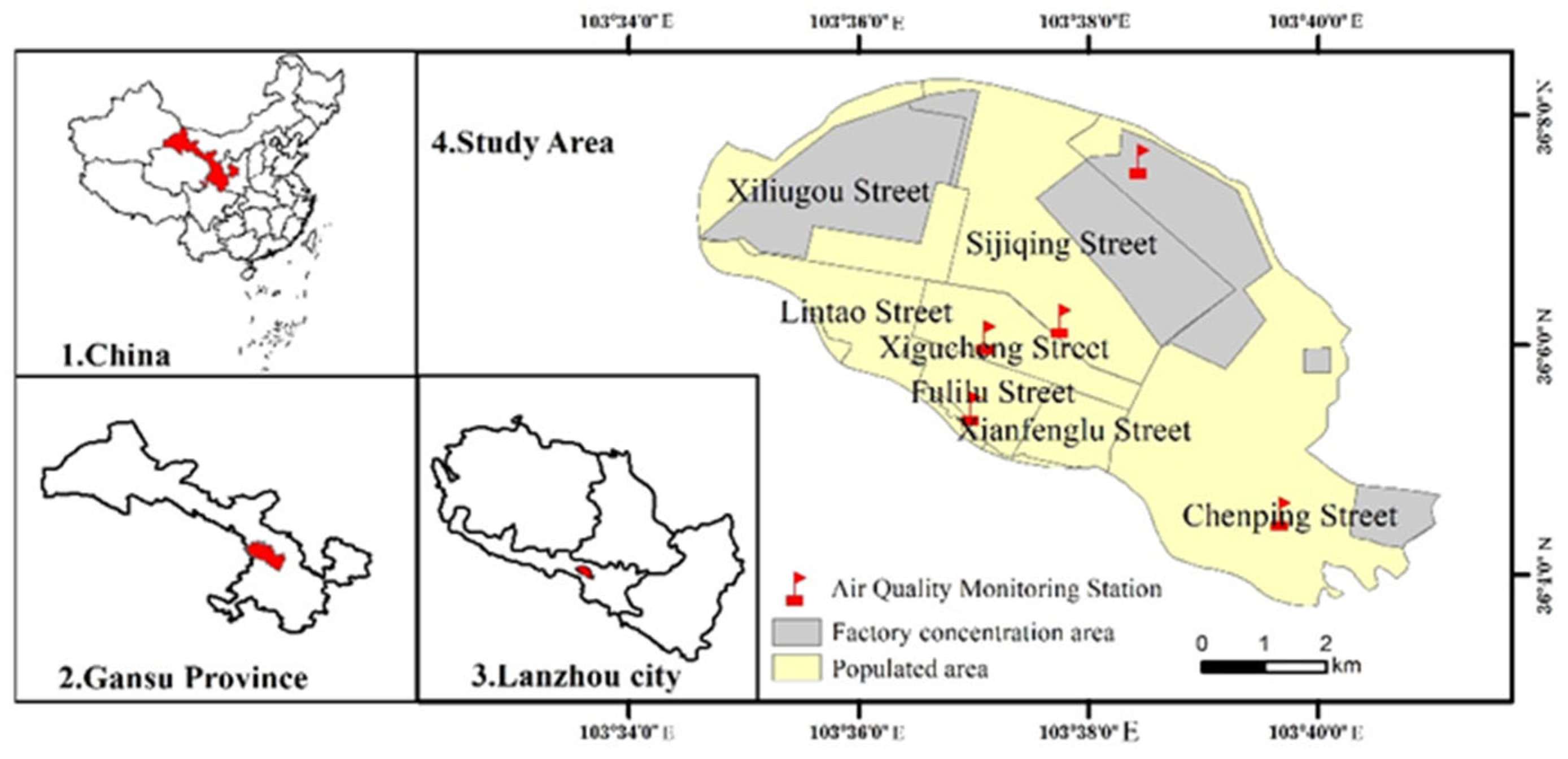
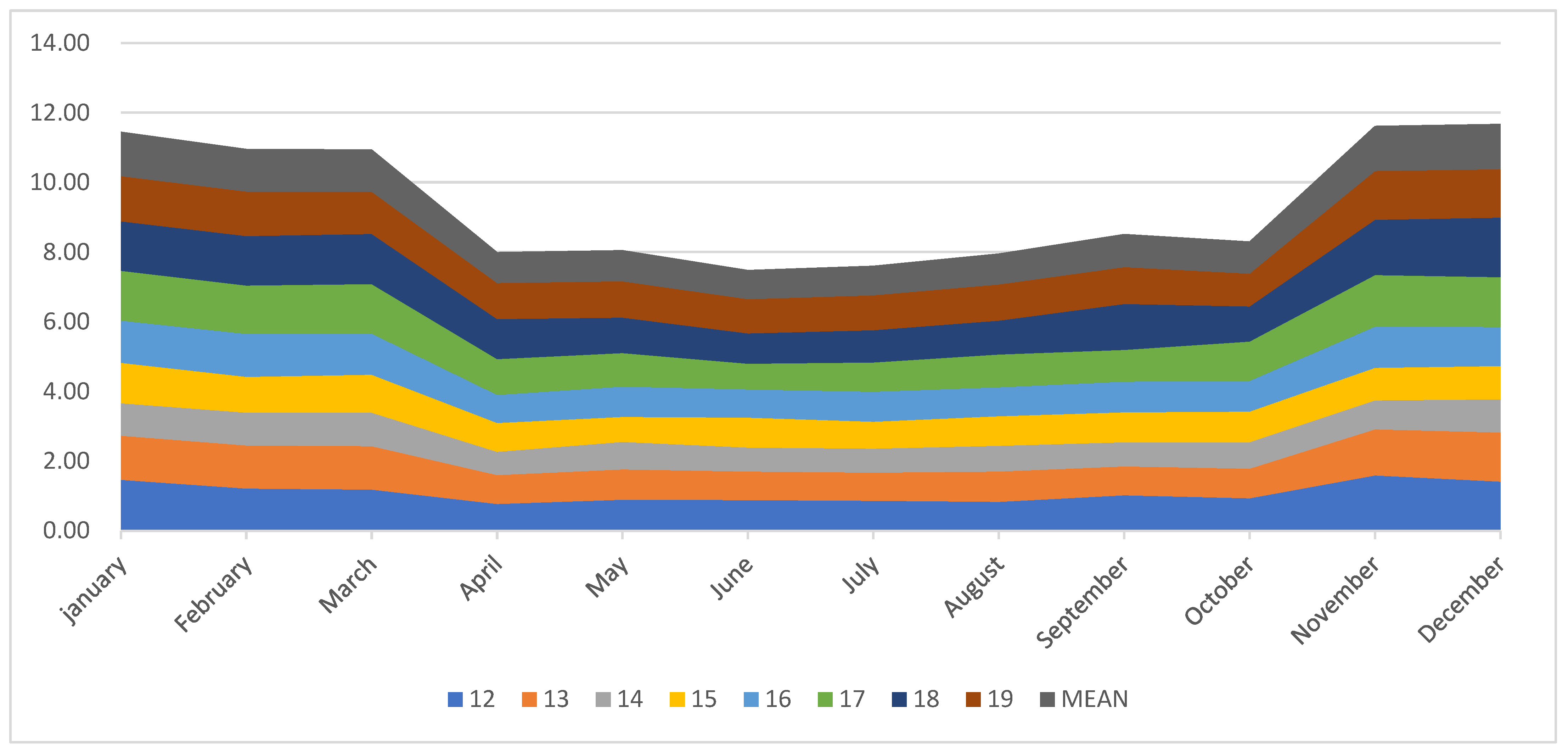

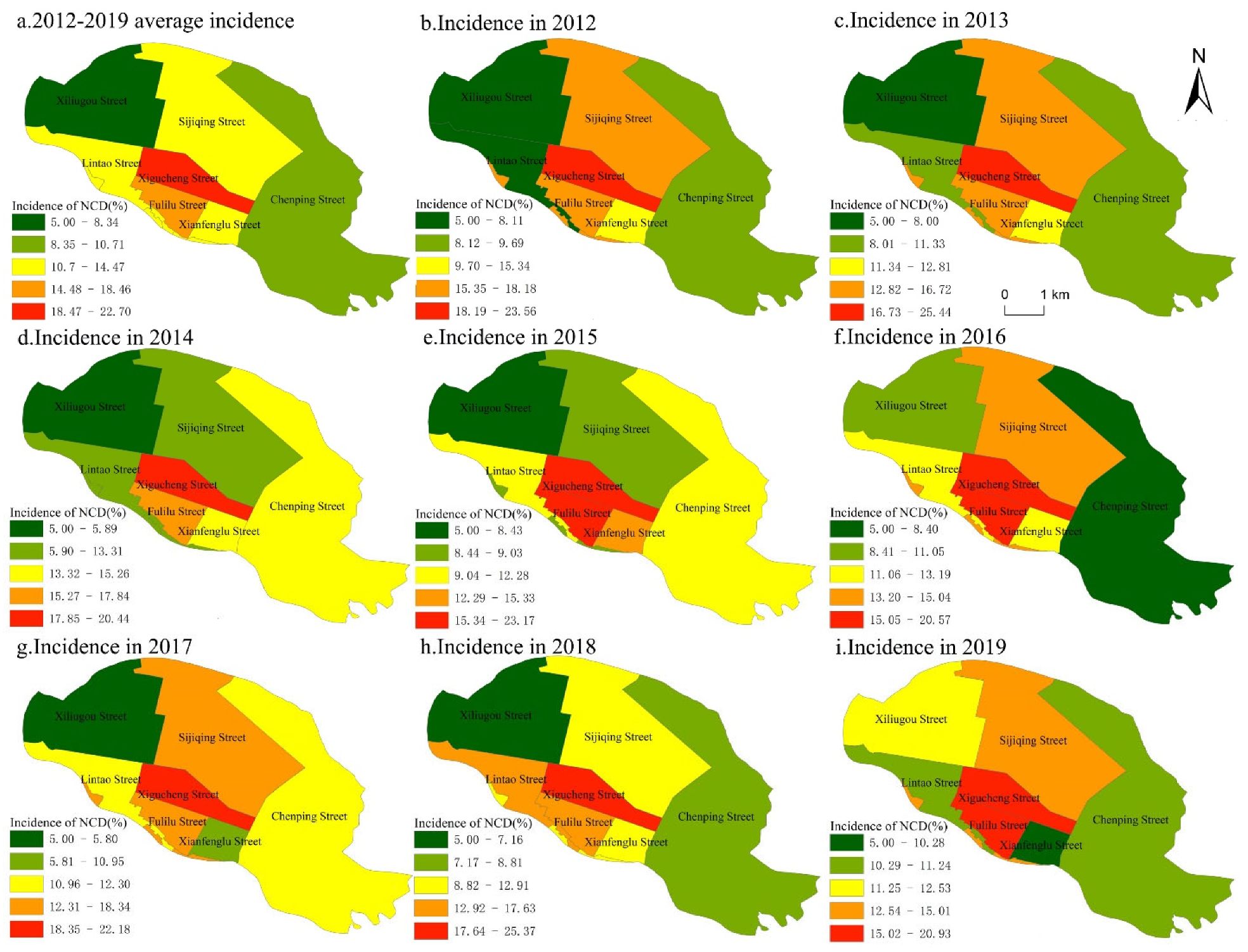
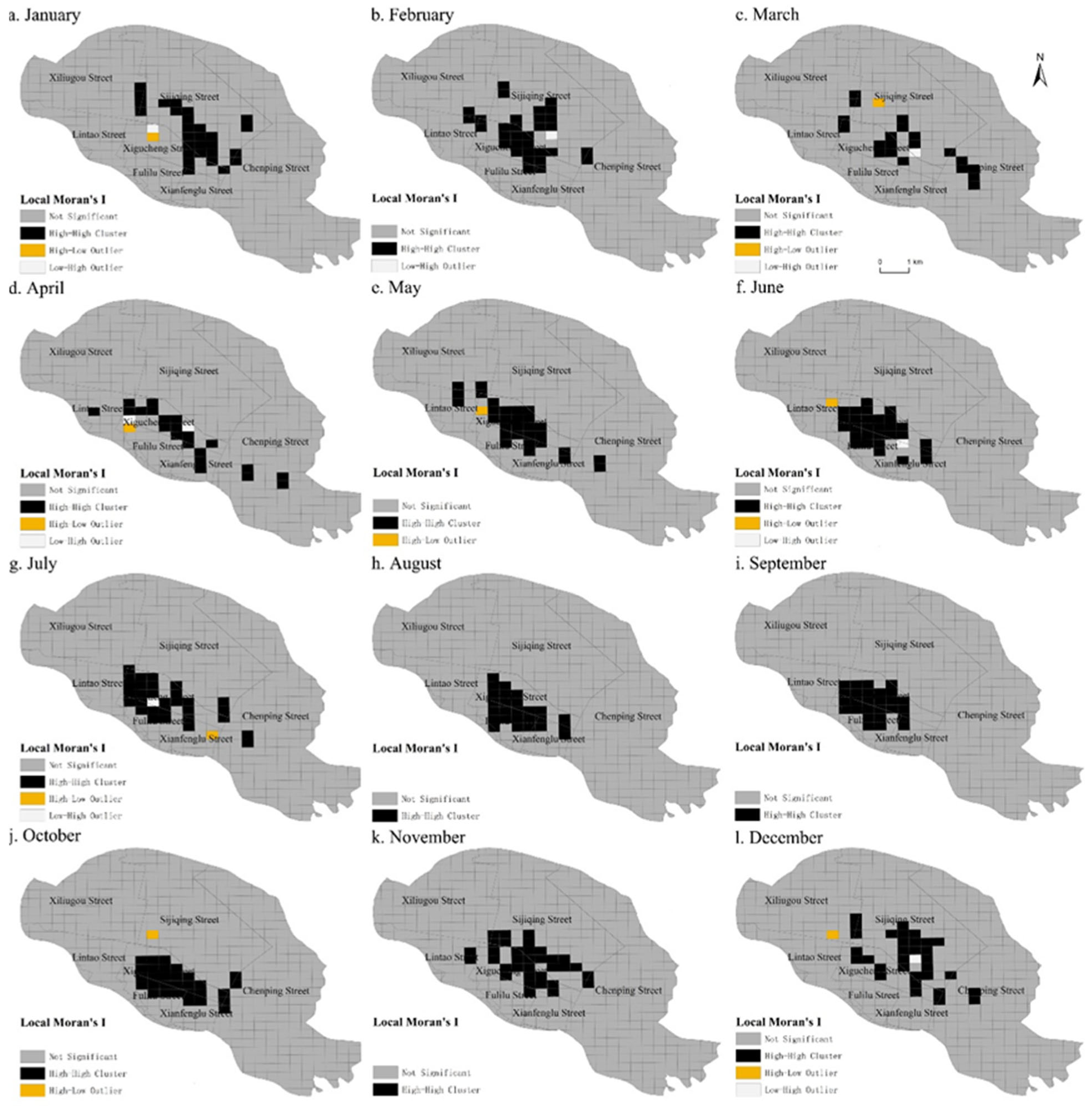

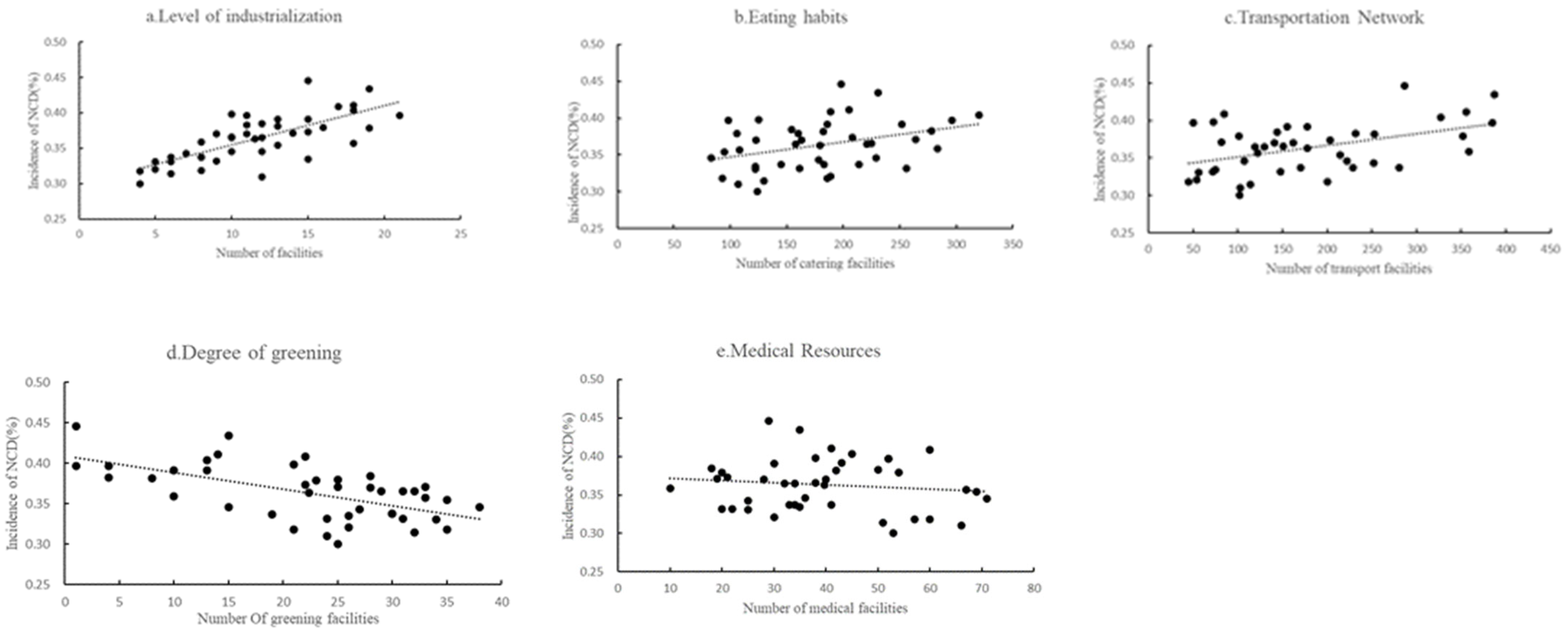
| Factors | Top Order | Secondary Order | Expected Direction | Amount |
|---|---|---|---|---|
| Air pollution | SO₂ | Positive | 2920 | |
| PM2.5 | Positive | 2920 | ||
| NO₂ | Positive | 2920 | ||
| Greening rate | Greening facilities | Road greening, greenbelts in neighborhood, parks, etc. | Negative | 316 |
| Medical resources | Medical facilities | Hospitals, clinics, health centers, etc. | Negative | 1533 |
| Industrialization level | Factory facilities | Chemical plants, oil refineries, mechanical processing plants, cotton mills, power plants, etc. | Positive | 840 |
| Traffic network | Traffic facilities | Bus stations, train stations, toll stations, parking lots, etc. | Positive | 3542 |
| Dietary habits | Catering service | Chinese restaurants, foreign-style restaurants, casual dining restaurants, coffee houses, etc. | Positive | 3725 |
| No. | Probe Factors | Indexes |
|---|---|---|
| X1 | SO₂ | Industrial emission concentration |
| X2 | PM2.5 | Concentration of fine particles |
| X3 | NO₂ | Industrial emission concentration |
| X4 | Catering facilities | Amount |
| X5 | Factory facilities | Amount |
| X6 | Traffic facilities | Amount |
| X7 | Greening facilities | Amount |
| X8 | Medical facilities | Amount |
| Year | 2012 | 2013 | 2014 | 2015 | 2016 | 2017 | 2018 | 2019 | Average Value |
|---|---|---|---|---|---|---|---|---|---|
| Xigucheng Street | 0.85 | 2.73 | −2.27 | 0.46 | −2.14 | −0.53 | 2.66 | −1.78 | 22.71 |
| Fulilu Street | −0.28 | −1.74 | −0.62 | 2.16 | 0.65 | −0.12 | −0.83 | 0.79 | 18.46 |
| Xianfenglu Street | 2.08 | −0.45 | 2 | 2.07 | −0.07 | −2.31 | −0.35 | −2.98 | 13.26 |
| Lintaojie Street | −3.94 | −0.72 | 1.13 | 0.23 | 0.59 | 0.09 | 3.39 | −0.81 | 12.05 |
| Sijiqing Street | 2.78 | 0.71 | −1.16 | −5.44 | 0.57 | 3.82 | −1.79 | 0.54 | 14.47 |
| Chenping Street | −1.02 | −0.19 | 3.37 | 0.43 | −2.31 | 1.59 | −1.9 | 0.05 | 10.71 |
| Xiliugou Street | −0.47 | −0.34 | −2.45 | 0.09 | 2.71 | −2.54 | −1.18 | 4.19 | 8.34 |
| SO₂ | PM2.5 | NO₂ | Catering Service | Factory Facilities | Traffic Facilities | Greening Facilities | Medical Facilities | |
|---|---|---|---|---|---|---|---|---|
| q | 0.7230 | 0.6845 | 0.6993 | 0.6620 | 0.7483 | 0.5797 | 0.6420 | 0.2744 |
| p | 0.0000 | 0.0000 | 0.0000 | 0.0000 | 0.0000 | 0.0000 | 0.0000 | 0.0000 |
Publisher’s Note: MDPI stays neutral with regard to jurisdictional claims in published maps and institutional affiliations. |
© 2021 by the authors. Licensee MDPI, Basel, Switzerland. This article is an open access article distributed under the terms and conditions of the Creative Commons Attribution (CC BY) license (https://creativecommons.org/licenses/by/4.0/).
Share and Cite
Zhao, H.; Du, Y.; Li, J.; Wu, M.; Zhang, F. The Influence of Environment Factors on Chronic Non-Communicable Diseases in a Heavy Industry City—A Case of Xigu District of Lanzhou City. Sustainability 2021, 13, 12636. https://doi.org/10.3390/su132212636
Zhao H, Du Y, Li J, Wu M, Zhang F. The Influence of Environment Factors on Chronic Non-Communicable Diseases in a Heavy Industry City—A Case of Xigu District of Lanzhou City. Sustainability. 2021; 13(22):12636. https://doi.org/10.3390/su132212636
Chicago/Turabian StyleZhao, Haili, Yuhan Du, Jialiang Li, Minghui Wu, and Fang Zhang. 2021. "The Influence of Environment Factors on Chronic Non-Communicable Diseases in a Heavy Industry City—A Case of Xigu District of Lanzhou City" Sustainability 13, no. 22: 12636. https://doi.org/10.3390/su132212636
APA StyleZhao, H., Du, Y., Li, J., Wu, M., & Zhang, F. (2021). The Influence of Environment Factors on Chronic Non-Communicable Diseases in a Heavy Industry City—A Case of Xigu District of Lanzhou City. Sustainability, 13(22), 12636. https://doi.org/10.3390/su132212636





